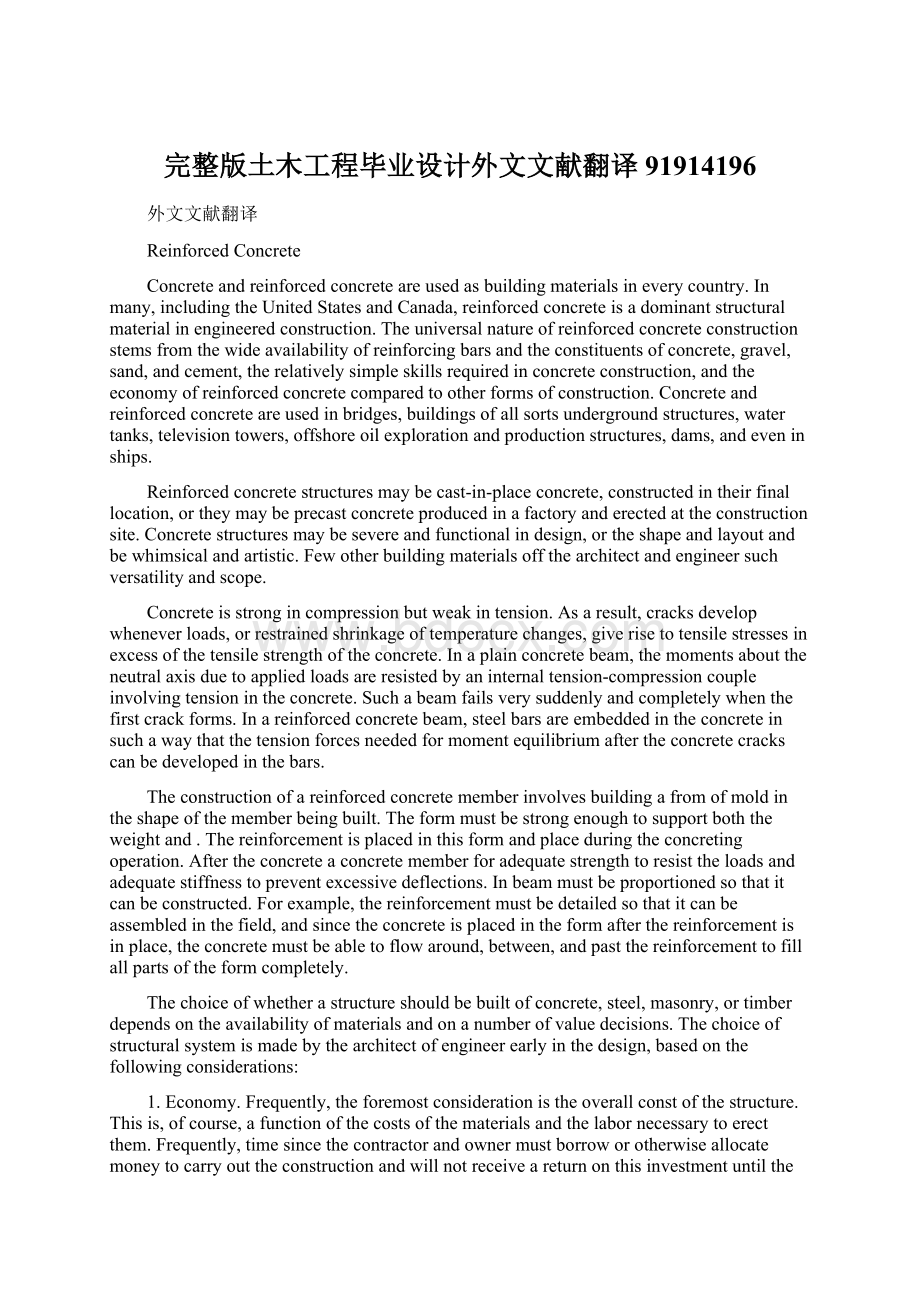完整版土木工程毕业设计外文文献翻译91914196.docx
《完整版土木工程毕业设计外文文献翻译91914196.docx》由会员分享,可在线阅读,更多相关《完整版土木工程毕业设计外文文献翻译91914196.docx(7页珍藏版)》请在冰豆网上搜索。

完整版土木工程毕业设计外文文献翻译91914196
外文文献翻译
ReinforcedConcrete
Concreteandreinforcedconcreteareusedasbuildingmaterialsineverycountry.Inmany,includingtheUnitedStatesandCanada,reinforcedconcreteisadominantstructuralmaterialinengineeredconstruction.Theuniversalnatureofreinforcedconcreteconstructionstemsfromthewideavailabilityofreinforcingbarsandtheconstituentsofconcrete,gravel,sand,andcement,therelativelysimpleskillsrequiredinconcreteconstruction,andtheeconomyofreinforcedconcretecomparedtootherformsofconstruction.Concreteandreinforcedconcreteareusedinbridges,buildingsofallsortsundergroundstructures,watertanks,televisiontowers,offshoreoilexplorationandproductionstructures,dams,andeveninships.
Reinforcedconcretestructuresmaybecast-in-placeconcrete,constructedintheirfinallocation,ortheymaybeprecastconcreteproducedinafactoryanderectedattheconstructionsite.Concretestructuresmaybesevereandfunctionalindesign,ortheshapeandlayoutandbewhimsicalandartistic.Fewotherbuildingmaterialsoffthearchitectandengineersuchversatilityandscope.
Concreteisstrongincompressionbutweakintension.Asaresult,cracksdevelopwheneverloads,orrestrainedshrinkageoftemperaturechanges,giverisetotensilestressesinexcessofthetensilestrengthoftheconcrete.Inaplainconcretebeam,themomentsabouttheneutralaxisduetoappliedloadsareresistedbyaninternaltension-compressioncoupleinvolvingtensionintheconcrete.Suchabeamfailsverysuddenlyandcompletelywhenthefirstcrackforms.Inareinforcedconcretebeam,steelbarsareembeddedintheconcreteinsuchawaythatthetensionforcesneededformomentequilibriumaftertheconcretecrackscanbedevelopedinthebars.
Theconstructionofareinforcedconcretememberinvolvesbuildingafromofmoldintheshapeofthememberbeingbuilt.Theformmustbestrongenoughtosupportboththeweightand.Thereinforcementisplacedinthisformandplaceduringtheconcretingoperation.Aftertheconcreteaconcretememberforadequatestrengthtoresisttheloadsandadequatestiffnesstopreventexcessivedeflections.Inbeammustbeproportionedsothatitcanbeconstructed.Forexample,thereinforcementmustbedetailedsothatitcanbeassembledinthefield,andsincetheconcreteisplacedintheformafterthereinforcementisinplace,theconcretemustbeabletoflowaround,between,andpastthereinforcementtofillallpartsoftheformcompletely.
Thechoiceofwhetherastructureshouldbebuiltofconcrete,steel,masonry,ortimberdependsontheavailabilityofmaterialsandonanumberofvaluedecisions.Thechoiceofstructuralsystemismadebythearchitectofengineerearlyinthedesign,basedonthefollowingconsiderations:
1.Economy.Frequently,theforemostconsiderationistheoverallconstofthestructure.Thisis,ofcourse,afunctionofthecostsofthematerialsandthelabornecessarytoerectthem.Frequently,timesincethecontractorandownermustborroworotherwiseallocatemoneytocarryouttheconstructionandwillnotreceiveareturnonthisinvestmentuntilthebuildingisreadyforoccupancy.Inatypicallargeapartmentofcommercialproject,thecostofconstructionfinancingwillbeasignificantfractionofthetotalcost.Asaresult,financialsavingsduetorapidconstructionmaymorethanoffsetincreasedmaterialcosts.Forthisreason,anymeasuresthedesignercantaketostandardizethedesignandformingwillgenerallypayoffinreducedoverallcosts.
Inmanycasesthelong-termeconomyofthestructuremaybemoreimportantthanthefirstcost.Asaresult,maintenanceanddurabilityareimportantconsideration.
2.Suitabilityofmaterialforarchitecturalandstructuralfunction.Areinforcedconcretesystemfrequentlyallowsthedesignertocombinethearchitecturalandstructuralfunctions.Concreteaplasticconditionandisgiventhedesiredshapeandtexturebymeansoftheformsandthefinishingtechniques.Thisallowssuchelementsadflatplatesorothertypesofslabstoserveasload-bearingelementswhileprovidingthefinishedfloorandorceilingsurfaces.Similarly,reinforcedconcretewallscanprovidearchitecturallyattractivesurfacesinadditiontoabuildingmustwithstandtheeffectsofafireandremainstandingwhilethebuildingisevacuatedandthefireisextinguished.Aconcretebuildinginherentlysimilarfireratings.
4.Lowmaintenance.Concretemembersinherentlyrequirelessmaintenancethandostructuralsteelortimbermembers.Thisisparticularlytrueifdense,air-entrainedconcreteusedforsurfacesexposedtotheatmosphere,andifcaretakeninthedesigntoprovideadequatedrainageoffandawayfromthestructure.Specialprecautionsmustbetakenforconcreteexposedtosaltssuchasdeicingchemicals.
5.Availabilityofmaterials.Sand,gravel,cement,andconcretemixingfacilitiesareverywidelyavailable,andreinforcingsteelcanbetransportedtomostjobsitesmoreeasilythancanstructuralsteel.Asaresult,reinforcedconcreteisfrequentlyusedinremoteareas.
Ontheotherreinforcedconcrete.Theseinclude:
1.Lowtensilestrength.Thetensilestrengthconcreteismuchlowerthanitscompressivestrength(about110),andstructuralusesthisisovercomebyusingreinforcementtocarrytensileforcesandlimitcrackwidthstowithinacceptablevalues.Unlesscareistakenindesignandconstruction,ofwater.Whenthisoccurs,waterorchemicalssuchasroaddeicingsaltsmaycausedeteriorationorstainingoftheconcrete.Specialdesigndetailsarerequiredinsuchcases.Inthecaseofwater-retainingstructures,specialdetailsandofprestressingarerequiredtopreventleakage.
2.Formsandshoring.Theconstructionofacast-in-placestructureinvolvesthreestepsnotencounteredintheconstructionofsteelortimberstructures.Theseare(a)theconstructionoftheforms,(b)theremovaloftheseforms,and(c)proppingorshoringthenewconcretetosupportitsweightuntilitsstrengthisadequate.Eachofthesestepsinvolveslaborandormaterials,whicharenotnecessarywithotherformsofconstruction.
3.Relativelylowstrengthperunitofweightforvolume.Thecompressivestrengthofconcreteisroughly5to10%thatofsteel,whileitsunitdensityisroughly30%thatofsteel.Asaresult,aconcretestructurerequiresalargervolumeandagreaterweightofmaterialthandoesacomparablesteelstructure.Asaresult,long-spanstructuresareoftenbuiltfromsteel.
4.Time-dependentvolumechanges.Bothconcreteandsteelundergo-approximatelythesameamountofthermalexpansionandcontraction.Becausethereislessmassofsteeltobeisaconcretestructure.Ontheotheralmosteverybranchofcivilengineeringandarchitectureextensiveuseismadeofreinforcedconcreteforstructuresandfoundations.Engineersandarchitectsrequiresbasicknowledgeofreinforcedconcretedesignthroughouttheirprofessionalcareers.Muchofthistextisdirectlyconcernedwiththebehaviorandproportioningofcomponentsthatmakeuptypicalreinforcedconcretestructures-beams,columns,andslabs.Oncethebehavioroftheseindividualelementsisunderstood,thedesignerwillawiderangeofcomplexstructures,suchasfoundations,buildings,andbridges,composedoftheseelements.
Sincereinforcedconcreteisanoacourseinstrengthofmaterialsforinthereforeempirical,i.e.,designequationsanddesignmethodsarebasedonexperimentalandtime-provedresultsinsteadofbeingderivedexclusivelyfromtheoreticalformulations.
Athoroughunderstandingofthebehaviorofreinforcedconcretewillallowthedesignertoconvertanotherwisebrittlematerialintotoughductilestructuralelementsandtherebytakeadvantageofconcrete’sdesirablecharacteristics,itssand),coarseaggregate,andfrequentlyotheradditives(thatmodifyproperties)intoaworkablemixture.Initsunhardenedorplasticstate,concretecanbeplacedinformstoproducealargevarietyofstructuralelements.Althoughthecompression,itlackstensilestrengthandthereforecrackseasily.Becauseunreinforcedconcreteisbrittle,itcannotundergolargedeformationsunderloadandfailssuddenly-withoutwarning.Theadditionfosteelreinforcementtotheconcretereducesthenegativeeffectsofitstwoprincipalinherentweaknesses,itssusceptibilitytocrackinganditsbrittleness.Whenthereinforcementisstronglybondedtotheconcrete,astrong,stiff,andductileconstructionmaterialisproduced.Thismaterial,calledreinforcedconcrete,isusedextensivelytoconstructfoundations,structuralframes,storagetakes,shellroofs,whenconcreteisreinforcedareshrinkageandcreep,butthenegativeeffectsofthesepropertiescanbemitigatedbycarefuldesign.
Acodeisasettechnicalspecificationsandstandardsthatcontrolimportantdetailsofdesignandconstruction.Thepurposeofcodesitproducestructuressothatthepublicwillbeprotectedfrompoorofinadequateandconstruction.
Twotypesfcoedsexist.Onetype,calledastructuralcode,isoriginatedandcontrolledbyspecialistswhoareconcernedwiththeproperuseofaspecificmaterialorwhoareinvolvedwiththesafedesignofaparticularclassofstructures.
Thesecondtypeofcode,calledabuildingcode,isestablishedtocoverconstructioninagivenregion,oftenacityorastate.Theobjectiveofabuildingcodeisalsotoprotectthepublicbyaccountingfortheinfluenceofthelocalenvironmentalconditionsonconstruction.Forexample,localauthoritiesmayspecifyadditionalprovisionstoaccountforsuchregionalconditionsasearthquake,ConcreteInstitute(ACI